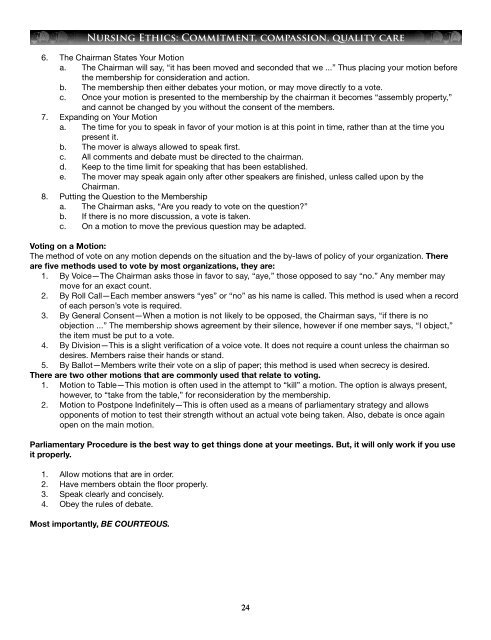You also want an ePaper? Increase the reach of your titles
YUMPU automatically turns print PDFs into web optimized ePapers that Google loves.
Nursing Ethics: Commitment, compassion, quality care<br />
6. The Chairman States Your Motion<br />
a. The Chairman will say, “it has been moved and seconded that we ...” Thus placing your motion before<br />
the membership for consideration and action.<br />
b. The membership then either debates your motion, or may move directly to a vote.<br />
c. Once your motion is presented to the membership by the chairman it becomes “assembly property,”<br />
and cannot be changed by you without the consent of the members.<br />
7. Expanding on Your Motion<br />
a. The time for you to speak in favor of your motion is at this point in time, rather than at the time you<br />
present it.<br />
b. The mover is always allowed to speak first.<br />
c. All comments and debate must be directed to the chairman.<br />
d. Keep to the time limit for speaking that has been established.<br />
e. The mover may speak again only after other speakers are finished, unless called upon by the<br />
Chairman.<br />
8. Putting the Question to the Membership<br />
a. The Chairman asks, “Are you ready to vote on the question?”<br />
b. If there is no more discussion, a vote is taken.<br />
c. On a motion to move the previous question may be adapted.<br />
Voting on a Motion:<br />
The method of vote on any motion depends on the situation and the by-laws of policy of your organization. There<br />
are five methods used to vote by most organizations, they are:<br />
1. By Voice—The Chairman asks those in favor to say, “aye,” those opposed to say “no.” Any member may<br />
move for an exact count.<br />
2. By Roll Call—Each member answers “yes” or “no” as his name is called. This method is used when a record<br />
of each person’s vote is required.<br />
3. By General Consent—When a motion is not likely to be opposed, the Chairman says, “if there is no<br />
objection ...” The membership shows agreement by their silence, however if one member says, “I object,”<br />
the item must be put to a vote.<br />
4. By Division—This is a slight verification of a voice vote. It does not require a count unless the chairman so<br />
desires. Members raise their hands or stand.<br />
5. By Ballot —Members write their vote on a slip of paper; this method is used when secrecy is desired.<br />
There are two other motions that are commonly used that relate to voting.<br />
1. Motion to Table—This motion is often used in the attempt to “kill” a motion. The option is always present,<br />
however, to “take from the table,” for reconsideration by the membership.<br />
2. Motion to Postpone Indefinitely—This is often used as a means of parliamentary strategy and allows<br />
opponents of motion to test their strength without an actual vote being taken. Also, debate is once again<br />
open on the main motion.<br />
Parliamentary Procedure is the best way to get things done at your meetings. But, it will only work if you use<br />
it properly.<br />
1. Allow motions that are in order.<br />
2. Have members obtain the floor properly.<br />
3. Speak clearly and concisely.<br />
4. Obey the rules of debate.<br />
Most importantly, BE COURTEOUS.<br />
24

















